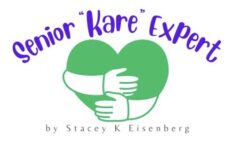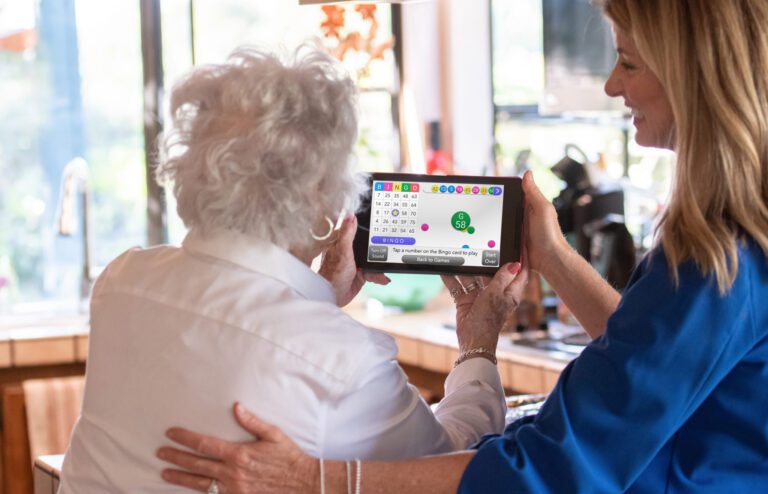Imagine a scenario where every grandparent can see the joy in their family member’s face through a video call, every cherished friend is just a simple phone call away, and the daily news, reminders and entertainment are accessible with ease. With the right tools, seniors can truly enjoy the warmth of connection and the freedom of independence. Let’s dive into the most popular options available, explore their features, and find out which device might just be the key to unlocking a world of communication for the senior in your life.
Raz Mobility: For those with Dementia or Visually and Hearing Impaired
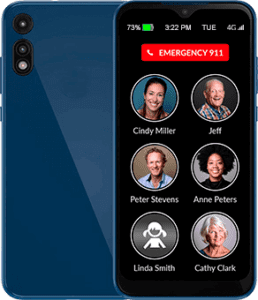

Raz Mobility: Ideal for Memory Issues
- Best Used For: Seniors with memory loss, dementia, or Alzheimer’s.
- Pros: Simple interface displaying contacts with photos; remote management by caregivers.
- Cons: Volume levels may not suffice for the hard of hearing.
- Addressed Issues: Simple calling process for those who struggle with memory or cognitive functions.
Jitterbug: Simplicity at Its Finest
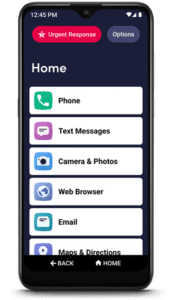

Jitterbug: Simplifying Smart Phones
- Best Used For: Seniors seeking simplicity, those with dexterity or mild memory issues.
- Pros: Large buttons, straightforward interface, emergency services button.
- Cons: Limited app ecosystem.
- Addressed Issues: Offers an easy-to-use device that doesn’t overwhelm users with complex features.
iPhone: A Full Spectrum of Options
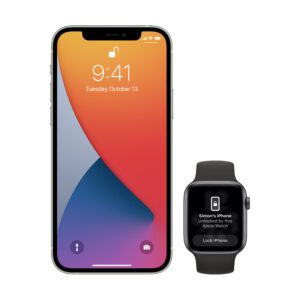

Accessibility settings that you can configure on the iPhone include:
– VoiceOver: Reads out what’s on the screen.
– Magnifier: Turns the iPhone into a digital magnifying glass.
– Larger Text: Increases text size across apps.
– Hearing Devices: Streamlines audio directly to compatible hearing aids.
– Siri: Allows for hands-free use and voice commands.
Combining the iPhone and Apple Watch offers a larger safety net for users, especially seniors or those with medical conditions, through advanced fall detection and medical response features. These features are designed to detect when a user might be in trouble and take steps to ensure help is on the way, if needed. Here’s a deeper look into how these devices work together to offer peace of mind and initiate assistance in critical situations.
Fall Detection on Apple Watch
- How It Works: The Apple Watch Series 4 and later models come equipped with fall detection technology. Using the watch’s accelerometer and gyroscope, the device can identify the unique motion patterns associated with a hard fall. When a fall is detected, the watch vibrates, sounds an alarm, and displays an alert asking if the user is okay. If the user is immobile for about a minute after the fall, the watch automatically places a call to emergency services and sends a message along with the user’s location to emergency contacts.
- Setting Up Fall Detection: Users can enable fall detection through the Watch app on their iPhone. It’s found under the “Emergency SOS” settings. While it’s automatically turned on for users over age 65 who have entered their age in the Health app, it can be manually activated for others.
Medical ID and Emergency SOS on iPhone
- Medical ID Creation: The iPhone’s Health app allows users to create a Medical ID, which is accessible from the lock screen without needing the device’s passcode. This ID can contain critical health information such as allergies, medical conditions, medications, blood type, and emergency contacts. This ensures that first responders have access to vital health information in an emergency.
- Emergency SOS: By pressing and holding the side button and one of the volume buttons on the iPhone, users can quickly call emergency services. On the Apple Watch, pressing and holding the side button achieves the same result. The device will also notify emergency contacts listed in the Medical ID with the user’s current location.
iPhone: A Versatile Tool with Comprehensive Accessibility
- Best Used For: Tech-friendly seniors and those with vision, hearing, or dexterity issues.
- Pros: Wide range of accessibility features (VoiceOver, Magnifier, customizable touch settings, Siri).
- Cons: Higher price point, may have a learning curve.
- Addressed Issues: Offers customizable solutions for a variety of accessibility needs. Important settings to configure include:
- VoiceOver for the visually impaired.
- Hearing aids compatibility and visual alerts for the hearing impaired.
- Magnifier and larger text for those with vision issues.
- Touch accommodations for users with dexterity challenges.
@mytechsocial101 How To Turn On Senior Mode On iPhone ( Assistive Access Fearure) #ios17 #iphone #iphonetips #iphonehacksyouneedtoknow #iphonetricks #iphoneseniors ♬ original sound – Tech Social 101
Alexa Echo Show: More Than Just a Gadget
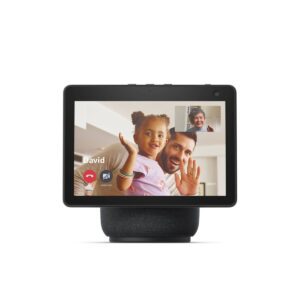

For example, using the Alexa app you would be able to “drop in” on your loved one. What that does is it activates the camera on the Show and you can see and hear your loved one without them having to do anything. It also allowed your loved one to say “Alexa, call Mimi” and it will. It can also be programmed to do other things for your loved one (such as “play NPR” or “tell me a joke” or “play my playlist”). You can type up a sheet using a large font, laminate it, where it has all the Alexa commands you think they would use. One of the recommendations I have seen is setting the Alexa device up with a paid Spotify account. This way you can have a playlist set up that plays all day long. A great selection of music can keep your loved one singing along and happy. It can also be used to turn other devices like a TV or lights on and off. You can also set it up to provide reminders like medication reminders, create to-do and shopping lists, etc. You can also have it play white noise like ocean sounds to calm your loved one when they sleep.
Amazon Echo Show: Hands-Free Help
- Best Used For: Seniors with dexterity or mobility issues, those who enjoy visual aids.
- Pros: Voice activation, video calling capability, integrates with smart home devices.
- Cons: Requires Wi-Fi; privacy concerns.
- Addressed Issues: Provides a hands-free, visually engaging way to communicate and access information.
Grandpad
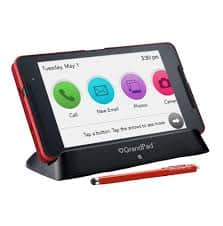

Key features of the GrandPad include:
– Large, clear fonts and colorful icons for better visibility and ease of use, especially for users with vision loss or colorblindness.
– Voice and video calling capabilities, allowing seniors to easily communicate with loved ones.
– Photo sharing, where family members can send pictures directly to the GrandPad, which can also act as a digital photo frame.
– Music streaming with access to a large library of songs, ad-free.
– Games and puzzles to keep the mind engaged, including solitaire, sudoku, and crosswords.
– 4G LTE data plan included with the subscription, providing nationwide connectivity without the need for Wi-Fi.
– Emergency calling features, including built-in 911 access for added safety.
– Charging cradle for easy wireless charging, suitable for seniors with dexterity issue.
– Customer support available 24/7 to assist with any issues or questions.
The GrandPad also offers a closed network to protect seniors from spam and scams, with the ability to make both outgoing and incoming calls. A family administrator can manage the device remotely, adding an extra layer of convenience and security.
GrandPad: Keeping It Simple and Secure
- Best Used For: Seniors who are new to technology, have vision or hearing impairments.
- Pros: User-friendly interface, preloaded apps, secure network.
- Cons: Requires subscription, dependent on Wi-Fi.
- Addressed Issues: Designed for ease of use, making digital communication and entertainment accessible.
CaptionCall
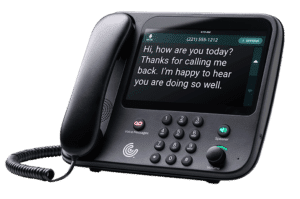

CaptionCall: For voice to text Conversations
- Best Used For: Individuals with significant hearing loss.
- Pros: Real-time captioning of phone conversations, customizable settings, saved transcripts.
- Cons: Limited to landline use; requires internet.
- Addressed Issues: Transforms phone calls into text, making it easier for the hearing impaired to communicate effectively.
smpl Hands-Free Dial Photo Memory Corded Phone
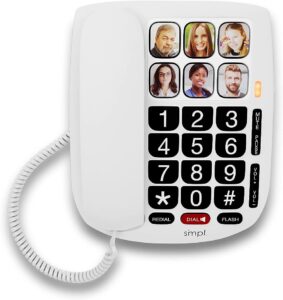

- Best Used For: Seniors, individuals with cognitive impairments such as memory issues, or those with physical limitations that make traditional phone use challenging. Anyone with access to a landline who prefers a more straightforward approach to making calls.
- Pros: Allows users to call frequently dialed numbers by pressing a single button associated with a photo, making it easier for those with memory challenges. Hands-Free Operation, allows for conversations without holding the handset. It offers adjustable volume settings, making it suitable for users with hearing impairments.The corded design ensures the phone doesn’t get misplaced, providing reliability and stability.
- Cons: Being corded, it restricts movement during calls, which may not suit all users. It requires physical photos for memory dialing, which could be a limitation if photos are not readily available or if changes to the contact list are frequent.
- Addressed Issues: The smpl Hands-Free Dial Photo Memory Corded Phone addresses several issues commonly faced by seniors and individuals with accessibility needs:
- Cognitive Challenges: By simplifying the dialing process with photo memory buttons, it reduces the cognitive load required to make a call.
- Hearing Impairments: Amplification features ensure that conversations are loud and clear, addressing the needs of the hearing impaired.
- Physical Limitations: Hands-free operation and easy-to-press buttons accommodate users with limited dexterity or those who cannot hold a phone comfortably.
- Visual Impairments: Large buttons and photo dialing assist users with poor vision, making it easier to identify and call contacts.
The smpl Hands-Free Dial Photo Memory Corded Phone exemplifies thoughtful design aimed at enhancing communication for those who face challenges with conventional phones. Its specialized features make it a valuable tool for seniors and individuals with accessibility needs, promoting independence and ease of use. While it may have some limitations, its benefits in addressing key issues make it a noteworthy option for anyone seeking a simplified, reliable communication device.
Best Communication and Phone Options for Seniors: Tailoring Technology to Fit Every Need
Choosing the right device involves considering the specific challenges a senior faces, as well as their comfort level with technology. For those with significant memory issues, the Raz Mobility phone reduces the cognitive load required to make calls. Jitterbug remains a favorite for its no-frills approach, suitable for users who prioritize ease of use above all else.
Tech-savvy seniors or those with a range of accessibility needs might find the iPhone’s comprehensive features most appealing, despite its price. Meanwhile, devices like the Alexa Show and GrandPad offer innovative ways to stay connected, blending simplicity with modern technology.
For hearing-impaired users, CaptionCall provides a solution that ensures no part of a conversation is missed, aligning with the need for clear communication in every call.


From a young age, Stacey’s link to the senior care industry grew alongside her mother’s work at a nursing home, where she often accompanied her. By her early teens, she secured her first official job at a nursing home, laying the foundation for a profound journey in senior care spanning over four decades. Her roles varied from opening assisted living and memory care residences to working in nursing homes and independent senior living communities. As the former Director of Fun for 300 independent seniors, she expertly organized daily events and trips. Stacey’s unwavering passion, nurtured by her family, and professional dedication as a recreation therapist, reflect her deep commitment to preserving the dignity and well-being of seniors.
Stacey’s senior care expertise has been recognized by the media including U.S. News and World Report and Care.com.
Stacey and her husband Bryan are the owners of the senior in-home care agency A Place At Home – North Austin.
